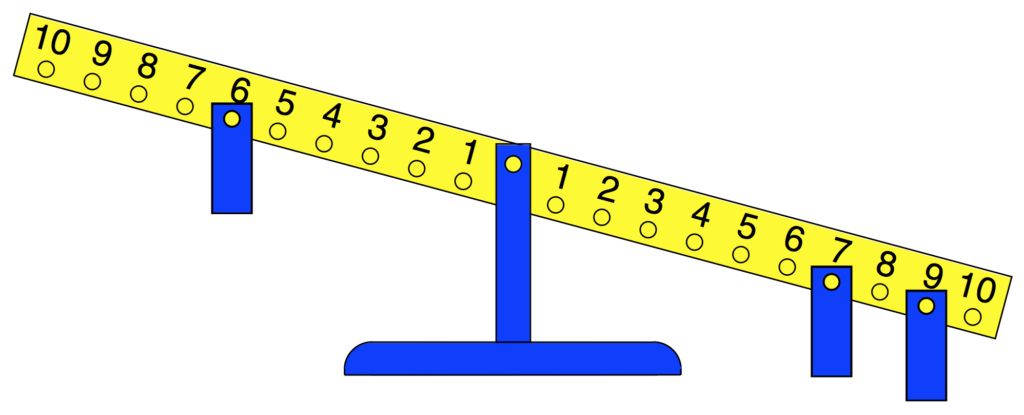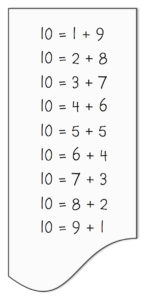So how’s your summer so far? It’s been great up here in Hazelton, North Dakota. The days are getting long – almost 17 hours of official sunlight! First light is at 5:11 am and last light is 10:07 pm, so it’s even longer when you’re outside and enjoying the fresh air. But the wind here has been crazy the last week… At least it’s not cold wind!
Well, this year, along with card games, we’re going to toss in some Math Balance activities. For those of you who don’t have the Math Balance, you’re going to want one. Trust me. Kids of all ages, from 2 to 92, just love exploring and working with this fantastic manipulative. Doesn’t matter what curriculum you use, they’re just going to love this!
Before you begin, be certain the Math Balance levels without the weights. If the arm is not parallel to the table or floor, adjust the small white weights on the bottom edge of the yellow balance arm. Move the weights to the right or left as needed.

Some of the balances are seriously out of balance; these need to have the white weights clipped on the TOP of the yellow arm. Then slide them left or right until you get the arm balanced. Now you’re ready to start putting the weights on the pegs!
When someone is new to the balance, I like to give them two weights and ask them to put them on the pegs and get it balanced. Let them figure it out. Most of the time, children will put the weights on the two 10s and adults will use numbers nearer the center, like 1, 2 or 3.

Once it’s balanced, ask “Why does this balance?” Adults will generally look at you like you’re slightly bonkers, but they’ll tell you they’re the same, so of course it’s balanced. Kids, depending on their age, understanding, and conversation abilities, will come up with a convoluted variation of “It’s the same.”
The question of why is important when working with a child (and some adults). We want to be certain that they understand the idea of “balance” and what makes it balanced. That is, the two sides need to be the same to balance. Now, me telling you this does not mean this is something you tell the kids. Just let them absorb the experience and not be burdened with your lecture on the “whys”. Let them enjoy the discovery themselves.
Depending on the age of the child, you may want to ask them if they can find another spot where the two weights will balance. Continue until they are confident with the activity and the results.

Next, give the child three weights. Tell them to put two on one side and one on the other and make it balance. Don’t indicate which side to put the two weights. Don’t give them clues or reminders. Let them explore.

If a child has difficulty, guide them by saying “leave this one here and let’s try moving this one.” Gently guide their efforts until it’s balanced.

Now ask “Why did this work?” Some will have already seen that it’s addition and quickly announce that 10 = 3 + 7. Others will come up with a more garbled version of the same. Avoid giving hints. Let them process and explain the whys of the situation. This explaining is part of the learning process.
For those that have no idea why it worked, ask “What is 3 +7?” After they answer, point to the 10 and wiggle your eyebrows (or your personal body language variation of “check that out!!”).
Ask the kids if this will work every time. This is an important question. I am continually flabbergasted at the number of kids that shrug their shoulders, look at me, and say “???yes???” while shaking their head no!
Ask the child to do it again, but to now put their two weighs on the other side. If they’re a bit older, tell them they can’t use the number 10 (or whatever number the first two weights added up to). This avoids a copy-paste of the first equation. Repeat your questions to get them to see the balanced result as an addition equation. Continue until the child grasps the concept with the three weights.

If the child is younger or struggling, I like to put one weight on the 10 and ask what two numbers we could use on the other side to make it balance. Then, say we have 1 and 9, I’ll move the weight on the 1-peg to the 2-peg and ask them to move the other weight to make it balance. Why does it balance? Because 2 + 8 = 10. Move the weight on the 2-peg to the 3-peg and ask the child to move the other weight. Why does it balance? Because 3 + 7 = 10. Keep going until the child sees the relationship. Don’t give hints. Your job is to guide the child to the discovery.

You might want to have the child record all the equations they can find using 10.

Explore with the Math Balance. Let them play. Let them enjoy the learning, the challenges, and the successes!
For the older ones, give them more weights and tell them to make it balance. Go with four or five or ten weights. Challenge them to have no duplicate numbers. Or to use certain numbers and not others.

Play and enjoy!! Use the comments below to let us know how it goes.

Just wondering where I can find those ideas on how to use the math balance with multiplication and division.
Thanks!
Julie – we don’t have that written up yet in a blog, however you can find it in the RS2 Level D, Lesson 40, RS2 Level E, Lessons 8 and 60, and RS2 Level F, Lessons 8 and 128. RS2 Level F also explores algebra on the Math Balance in Lesson 129.
Me to.
Hi, Bekah.
Here was the response to the question left to Julie Scott:
We don’t have that written up yet in a blog, however you can find it in the RS2 Level D, Lesson 40, RS2 Level E, Lessons 8 and 60, and RS2 Level F, Lessons 8 and 128. RS2 Level F also explores algebra on the Math Balance in Lesson 129.
If you have any additional questions, please feel free to post them here or to email us at [email protected].
Have a great day!